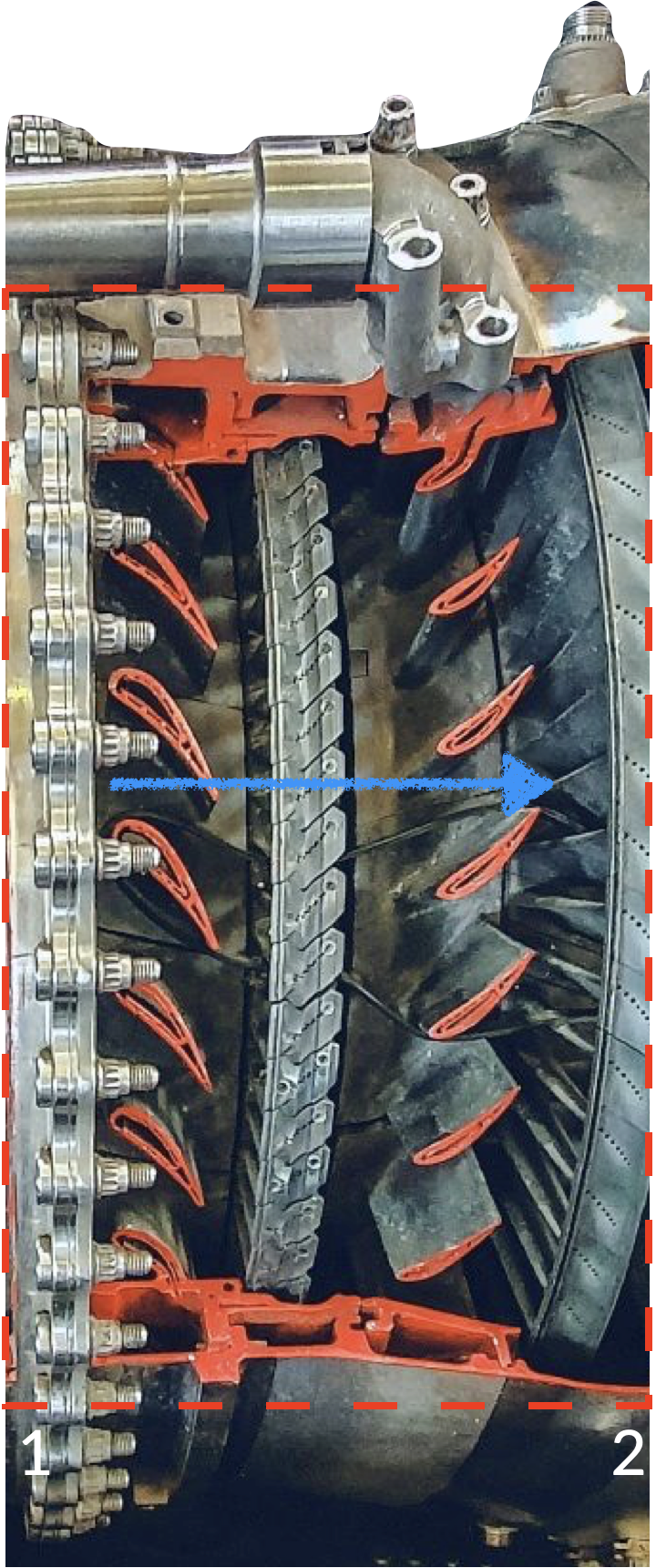L19 examples
Problem 1
Combustion gases enter the turbine of a jet engine at \(\require{color}{\color[rgb]{0.315209,0.728565,0.037706}15.0 \; bar}\) and \(\require{color}{\color[rgb]{0.164799,0.878862,0.723179}1250 \; K}\) with a velocity of \(\require{color}{\color[rgb]{0.059472,0.501943,0.998465}50 \; m/s}\). At the exit, the pressure, temperature, and velocity are \(\require{color}{\color[rgb]{0.315209,0.728565,0.037706}3.0 \; bar}\), \(\require{color}{\color[rgb]{0.164799,0.878862,0.723179}850 \; K}\) and \(\require{color}{\color[rgb]{0.059472,0.501943,0.998465}100 \; m/s}\) respectively. The exit area is given to be \(0.6 \; m^2\). Calculate the mass flow rate and the power output from the turbine. Assume perfect gas relations with \(R = 288 J/\left(kg \cdot K \right)\) and \(\require{color}{\color[rgb]{0.986252,0.007236,0.027423}c}_{\color[rgb]{0.315209,0.728565,0.037706}p} = {\color[rgb]{0.986252,0.007236,0.027423}1200 \; J/\left(kg \cdot K \right)}\).

(image above by Petr Kratochvil)
Solution
First, to work out the massflow rate we note that
\[ \large \require{color} \dot{m} = {\color[rgb]{0.918231,0.469102,0.038229}\rho_2} A_2 {\color[rgb]{0.059472,0.501943,0.998465}v_2} = \frac{{\color[rgb]{0.315209,0.728565,0.037706}p_2}}{R {\color[rgb]{0.164799,0.878862,0.723179}T_2}} \times A_2 \times {\color[rgb]{0.059472,0.501943,0.998465}v_2} = \frac{{\color[rgb]{0.315209,0.728565,0.037706}3 \times 10^5\; Pa}}{288 \times {\color[rgb]{0.164799,0.878862,0.723179}850}} \times 0.6 \times {\color[rgb]{0.059472,0.501943,0.998465}100} \]
\[ \large \require{color} \dot{m} = 73.5 \; \frac{kg}{s} \]
From the SFEE we have
\[ \large \require{color} {\color[rgb]{0.334690,0.296180,0.998454}q} - {\color[rgb]{0.562040,0.190215,0.568721}w_{x}} = \left({\color[rgb]{0.986252,0.007236,0.027423}h_2} - {\color[rgb]{0.986252,0.007236,0.027423}h_1} \right) + \left( \frac{1}{2} {\color[rgb]{0.059472,0.501943,0.998465}v_2}^2 - \frac{1}{2}{\color[rgb]{0.059472,0.501943,0.998465}v_1}^2 \right) \]
Assuming a perfect as we have \(\require{color}{\color[rgb]{0.986252,0.007236,0.027423}h} = {\color[rgb]{0.986252,0.007236,0.027423}c}_{\color[rgb]{0.315209,0.728565,0.037706}p} {\color[rgb]{0.164799,0.878862,0.723179}\Delta T}\) leading to
\[ \large \require{color} -{\color[rgb]{0.562040,0.190215,0.568721}w_x} = {\color[rgb]{0.986252,0.007236,0.027423}c}_{\color[rgb]{0.315209,0.728565,0.037706}p} \left({\color[rgb]{0.164799,0.878862,0.723179}T_2} - {\color[rgb]{0.164799,0.878862,0.723179}T_1} \right) + \frac{1}{2}\left( {\color[rgb]{0.059472,0.501943,0.998465}v_2}^2 - {\color[rgb]{0.059472,0.501943,0.998465}v_1}^2\right) \]
\[ \large \require{color} {\color[rgb]{0.562040,0.190215,0.568721}w_x} = {\color[rgb]{0.986252,0.007236,0.027423}c}_{\color[rgb]{0.315209,0.728565,0.037706}p} \left({\color[rgb]{0.164799,0.878862,0.723179}T_1} - {\color[rgb]{0.164799,0.878862,0.723179}T_2} \right) + \frac{1}{2}\left( {\color[rgb]{0.059472,0.501943,0.998465}v_1}^2 - {\color[rgb]{0.059472,0.501943,0.998465}v_2}^2\right) \]
\[ \large \require{color} \Rightarrow {\color[rgb]{0.562040,0.190215,0.568721}w_x} = {\color[rgb]{0.986252,0.007236,0.027423}1200} \left({\color[rgb]{0.164799,0.878862,0.723179}1250} - {\color[rgb]{0.164799,0.878862,0.723179}800} \right) + \frac{1}{2}\left( {\color[rgb]{0.059472,0.501943,0.998465}50}^2 - {\color[rgb]{0.059472,0.501943,0.998465}100}^2\right) = {\color[rgb]{0.562040,0.190215,0.568721}480 - 3.75} = {\color[rgb]{0.562040,0.190215,0.568721}476.25 \; \frac{kJ}{kg}} \]
The shaft power is then given by
\[ \large \require{color} {\color[rgb]{0.562040,0.190215,0.568721}\dot{w}_{x}} = \dot{m} {\color[rgb]{0.562040,0.190215,0.568721}w_{x}} = 73.5 \times {\color[rgb]{0.562040,0.190215,0.568721}476.25 \; \frac{kJ}{kg}} = 35 \; MW. \]